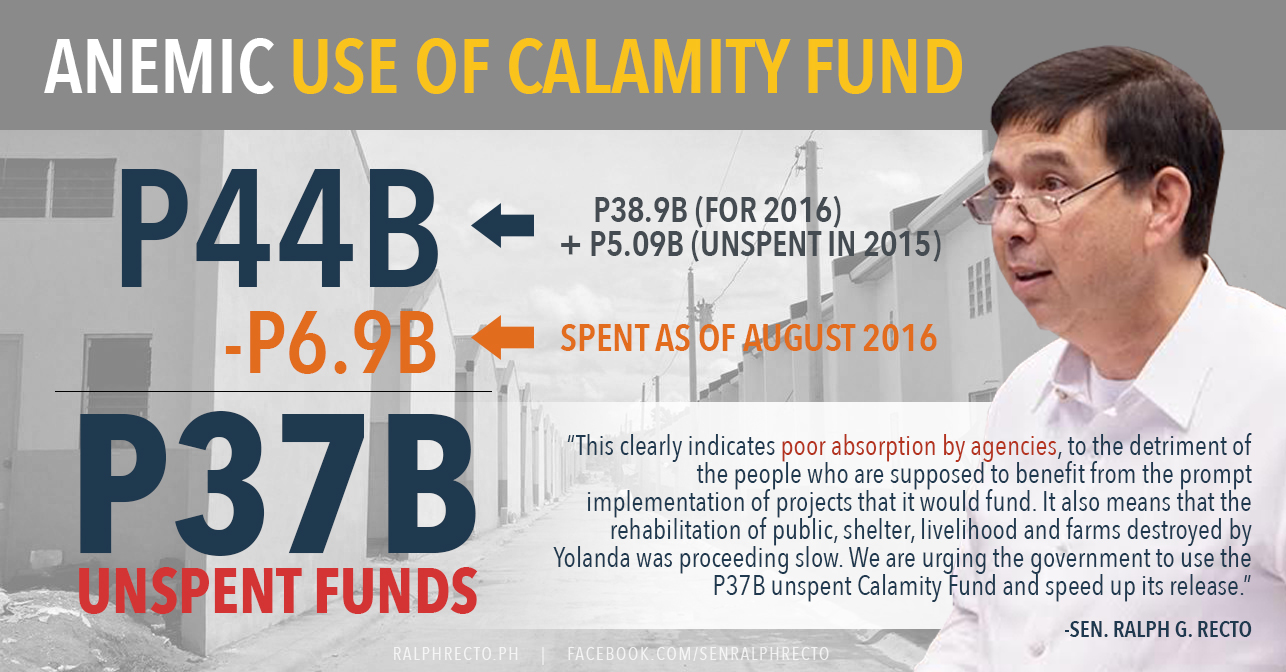No need for foreign aid; P37 B of Calamity Fund unspent as of Aug. 31 – Recto
The Calamity Fund posted an unspent balance of P37 billion as of August 31, foreclosing the need to solicit foreign aid to help victims of typhoon Lawin, Senate Minority Leader Ralph Recto said today.
“The challenge is to open the floodgates of domestic aid funds and not to ask help from abroad,” Recto said.
Recto said the available amount in the Calamity Fund – officially known as the National Disaster Risk Reduction and Management Fund (NDRRMF) – came from two sources : unused 2015 and current year appropriations.
For 2015, P14.06 billion was appropriated for the fund, of which P5.09 billion remained unused as of December 31, 2015.
This amount was added to the 2016 appropriations of P38.9 billion, raising the spendable amount for this year to almost P44 billion.
Availments as of end of August, however, totaled P6.9 billion, leaving a balance of P37 billion.
Even if fund withdrawal accelerated since then, “easily there is at least P30 billion still available,” he said.
“No major calamities had visited us this year. There are fewer typhoons, the number is way below the usual and we are already nearing the last two months of the year,” Recto said.
Recto said the low utilization of calamity funds also pointed to another anomaly, “that little help was extended to El Nino victims last summer.”
Instead of seeking foreign help, Recto is prodding the Duterte administration “to hack away” at the red tape slowing down the flow of rehabilitation funds to Lawin and other disaster-hit areas.
Recto said “complicated rules” governing the request, release and use of national calamity funds result in the trickle down of aid to areas which need rapid restoration.
He described the “cumbersome requirements” as “inherited regulations” which must be overhauled “if we want to send as much aid to people and places which need them most as fast as possible.”
“The war against red tape must also be fought in the disaster aid front,” Recto said. “Red tape itself is a man-made calamity.”
“If we want to turbocharge the release of aid money, then we must first change the rules,” Recto said in calling for the review of the procedures on how disaster-hit areas can access the Calamity Fund, or what is officially called NDRRMF.
“Kung i-diagram mo yung proseso, parang wiring ng kuryente. From request to release to procurement to delivery of reconstruction materials, easily one hundred steps. Kawawa talaga ang mga local governments,” Recto lamented.
The release involves “the interplay and layers of approval” of many agencies including the National Disaster and Risk Reduction and Management Council (NDRRMC), the Office of the President, and the Department of Budget and Management (DBM), Recto said.
He said a local government unit (LGU) flattened by a typhoon will have to submit documentary requirements “through a gauntlet of agencies.”
“Kung naanod na computer mo, nawawala ang encoder, at wala kang kuryente, magagawa mo pa ba ito?” Recto said.
The request is then checked by the Office of Civil Defense, which is the operating arm and secretariat of the NDRRMC.
After verification, it is sent to the Office of the President for approval. Once approved, the request is forwarded directly to the DBM, for another round of vetting. The DBM then issues the Special Allotment Release Order (SARO) and Notice of Cash Allocation (NCA) directly to the LGU.
“At ito ay sa pag-release pa lang ng pondo. Hindi pa pumapasok sa bidding, where another set of rules await under the Government Procurement Reform Act,” Recto said.
Recto said the procurement law “must be revisited insofar as the relaxation of rules for emergency relief purchases are concerned.”
“Kung parating na ang bagyo, may leeway ka dapat ibigay sa mga nandoroon sa frontlines, sa pagbili nang mga pagkain, halimbawa. Yung iba tuloy ayaw bumili kasi takot sa COA (Commission on Audit),” Recto said.
One way of expediting the procurement of relief goods and rehabilitation materials is for the government to open credit lines “to established big commercial establishments in the area, like a branch of a supermarket chain, like SM, and have this arrangement covered by a Memorandum of Agreement.”
Recto said government should also preposition “packed foodstuff, clothing, personal hygiene materials in identified regional warehouses.”
“Forward deployed na dapat. Para ready na at hindi yung magre-repack pa at ililipad mo pa mula Maynila,” he said.
Aside from these regional depots, government should also designate certain military camps as “area rallying points” where a composite brigade-size of military and civilian security, health, social welfare, engineering personnel can be assembled for rapid deployment to disaster zones.
RELATED ARTICLES:
-
23 OCT 2016: Recto: Cut red tape in the request, release, use of calamity funds
-
25 SEP 2016: Recto: Palace must review, monitor “anti-red tape fast action” targets of underlings
-
20 SEP 2016: Recto files ‘one time, big time’ tax amnesty bill
-
28 AUG 2016: Cut expenses red tape first before imposing new taxes
-
24 JUL 2016: Recto: FOI order should be red tape cutting device
-
12 JUL 2016: Recto: Anti-red tape czar needed to cut obsolete gov’t rules costing Ph P140 B a year
-
30 APR 2016: Recto: Next prexy must put red tape in hit list
-
11 APR 2016: Recto: Next pres must cut calamity aid red-tape; preposition aid to regions
-
09 APR 2016: Recto: Red tape voluminous documents hamper El Niño aid
-
09 NOV 2015: Publish ‘feesbook’ of permits, licenses to promote ease of doing business, cut red tape
-
21 SEP 2013: recto bill to cut red tape in GSIS
SENATE BILLS:
-
01 AUG 2016: Senate Bill No. 932: Improving Government Service Delivery, Amending Section 8 of the Anti-Red Tape Act of 2007


